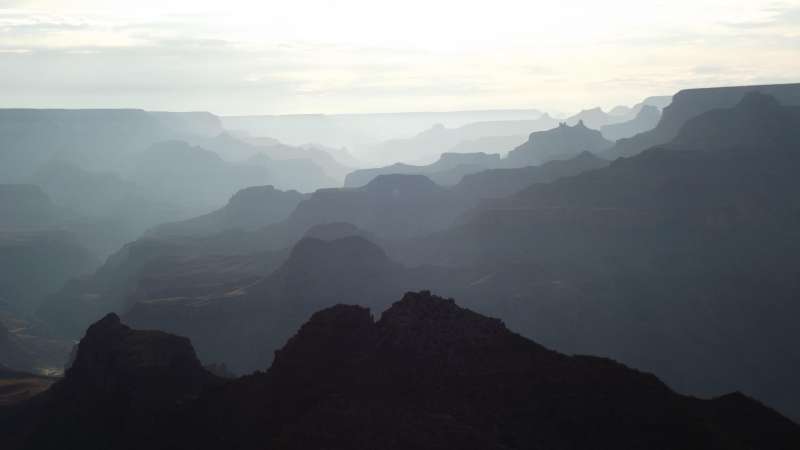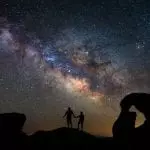An uncomfortable situation arises when a Christian scholar has to make the choice between biblical history and secular geologic history. Much of the world is convinced that as we travel through the geologic layers, fossil remains illustrate earth’s epically old biologic past.
Walk into practically any university geology class, and they will teach you that indeed the earth is old, and the universe much older. While secular science seems to reveal that the earth is millions of years old, a reading of the Bible reveals that biblical history is much shorter, estimated to be about 6,000 years old when you add the ages given in the genealogies.
This is why people are uncomfortable. On one hand, it’s not hard to take the Bible literally. On the other hand, it’s hard not to accept what mainstream science preaches. Some curious minds have decided the earth being millions of years old is such an established fact that this must be fit somewhere in the Bible.
The question is often asked, based upon an assumption that the earth looks really old, why would God lie and give the appearance of an old earth when the earth isn’t nearly that old? Because some are rightfully committed to believing in a God who does not lie, they say that the answer must mean the world IS millions of years old, and that the old age is not an illusion.
Why Do Scientists Say the Earth is Old?
It’s a silly question, but ask yourself what a million-year-old earth might look like. If I asked you what a fifty-year-old man might look like, you could give me a rough picture. You’ve known and seen many fifty-year-old men, so you can judge about what they may look like. Likewise, if you saw a man walking down the street you could guess his age because of the experiences you’ve had with people where you know their age and what they look like.
Though it sounds obvious, humans have no experience with other earths or planets; and we’ve certainly never had empirical, repeatable data where we knew another planet’s age to compare what it looks like.
Since there is no way to judge what an old earth might look like, the age of the earth is found by working backward.
Chemically speaking, if we can measure the rate of when one element decays into another, then use that rate to backtrack to when the initial element was 100% there, then we could find out the age of the mineral or organism. This is a simplified version of how radiometric dating works: by examining how long isotopic decay of elements occurs in the present, we can infer how long ago it was when the element had no decay.
This is how scientists get incredibly old ages for the earth from the seemingly slow process of elemental decay. This method is largely mathematical and relies on certain special conditions. Understand that we’ve never been able to empirically test the accuracy of the method because we haven’t been able to spend a million years seeing if our math agrees with the actual decay.
Another method of age-guessing occurs with geologic columns.
If you took a slice of the earth and examined the inside, you’d see an elaborate version of a multiple-layer cake with frosting inside. Over time, layers of different mineral components stack on top of each other, so in a slice of the earth, each layer of sediments would translate to a layer of cake. The mainstream theory about these different geologic layers is that the layers on the bottom are older than any of the layers on top of them. It’s like how the clothes on the bottom of the laundry hamper are older than any of the rest stacked on top. Each of these layers of sediments corresponds to a rough date. Any fossils in a layer are assumed to be the same age as the layer, and the layer is assumed to be the same age as any fossil that they “know” is a certain amount of years old.
The earth is assumed to be much, much older than 6,000 years because it seems like the earth has had a huge past—with so many layers representing multiple years and so much extinct life.
If your laundry pile is three stories high, I assume that you haven’t washed your clothes in a really long time, probably about a few months. All those layers of clothes and my estimation that you put one set of clothes in the hamper every day leads me to believe that the large pile is days upon days old. However, I rely on the assumption that you through on one set of clothes each day—perhaps that is not accurate. What would it mean for my estimated age if you actually put ten pairs of clothes on the pile every day?
Simply put, these dating methods are flat wrong about the actual age of the earth.
Maturity and Not Lies
So the earth “looks old.” If the Bible really says the earth is young, why has God tricked us into seeing a bunch of history that never happened? If the earth is 6,000 years old, then the million-year-old fossil can’t have been from a real animal. As an angry Twitter user once told me I’m not allowed to use million-year-old oil (for gasoline) because in my view the earth is so young that the oil shouldn’t exist. Are we to reject the young age of the Bible because the dates we are getting are so old?
Why would God lie to us about a history that never happened? Firstly, would having an alleged past of some sort really be lying? Lying is when someone doesn’t tell the truth. But having the appearance of age isn’t a matter of not telling the truth, but a matter of an illusion (Of sorts). I’d wager most people have seen an optical illusion, or have had their eyes trick them. Our eyes tell us something is one way when it is really another way. It looks as if the stairs keep going up in each direction, but somehow they all connect back to each other. It looks like that flat picture is three-dimensional. It looks as if the tree has a face in it. These are not examples of lies, but examples of our perception of things not being accurate.
When God created Adam and Eve in Genesis, they were mature adults (or at least they weren’t babies). It’s easy to see that Adam and Eve and the life in the garden were physically mature because of the elements we see unfold in the story.
Adam and Eve were instructed to reproduce (Genesis 1:28), Adam was to work the fields (2:5, 15), trees were reproductively mature enough to bear fruit and were at a physical point where they were pleasing to the eye (Genesis 2:9, 16), Adam was capable of adult speech (Genesis 20, 23) and Adam was intelligent enough to name animals and understand his own needs (Genesis 19, 20). Adam was not a day old, and already capable of speaking, eating, tending to a garden, and creative naming. Adam had the body and mind of an adult, but he was not 25 years old, but just a day old at the time of Genesis 2.
Is this age deception a lie from God? If you think it is, I’d ask you to imagine Adam being made as a baby in a world with only seeds planted among other newborn animals. Adam couldn’t accomplish God’s plan to subdue the earth and repopulate it, if he started out as a helpless baby. The physical maturity of the earth is NOT a lie, but a necessary miracle in accordance with God’s divine plan to have his focus on humans. God does not lie. Throwing out Genesis 1 and 2 because your mistake-making human buddies tell you the earth is super old is a worse stance than saying God makes things look older than they are so that his divine plan could be accomplished. God is quite capable of accurately communicating with humans through his Word, so the theories of man should not trump what God inspired certain men to write.
It seems to me, the world was made mature—the animals weren’t babies, plants were all grown up, and though everything was new, it probably didn’t look new— for Adam and Eve. At a glance, the earth would seem to look as if it was a lot older than I was—it’s an “optical illusion” where your eyes tell you something that isn’t exactly true because you don’t have all the data. This is not a lie that God made the earth fully formed, but a necessity to support human life.
Billions of Billion-year-old Fossils
The fossil record, on the other hand, is largely a result of the Flood of Genesis chapters 6,7,8. As creationist Ken Ham is quoted saying,
If there really was a Flood, what would the evidence be? Billions of dead things, buried in rock layers, laid down by water, all over the earth. What have we found? Billions of dead things, buried in rock layers, laid down by water, all over the earth.
All those fossils buried in all those rock layers that some claim are God’s great deception weren’t created as part of the “optical illusion” but were a result of an enormous watery catastrophe caused by God’s judgment of mankind. As the waters raged, dirt was picked up from one side of the earth and cast over an organism on another part, quickly freezing them as a fossil as only a large catastrophe can.
Evidence for rapid fossilization is shown by fossils of fish giving birth, animals in the middle of eating another animal, and even turtles mating — these are all instances where these creatures wouldn’t wait around for a million years but must have been preserved by fast action.
Additionally, trees spanning through multiple geologic layers show that each layer is not really a few millions of years old, since a tree would rot away to a form not able to be fossilized long before many millions of years could preserve it in multiple layers of rock. Clearly, the classical assumptions of the earth’s age are incorrect and in fact, God didn’t trick us with old-looking fossils but provided evidence for the catastrophe of Noah’s Flood.
The Reason for Creation
Think for a moment about why God created the universe. It was to have a special relationship with His creation. There is only one created being that has this relationship with God. Not cows, not ferrets, not barnacles, not pine trees — humans are a special creation unique from every other living creature. Among what makes us different is that we have free will—to choose to love God, or to choose to not love him. God made the earth for us, and he made it mature so it could feed and shelter his favorite creation. Isaiah 45:18 (NIV) gives us a little special information smack in the middle of a prophetic message:
For this is what the Lord says—he who created the heavens, he is God; he who fashioned and made the earth, he founded it; he did not create it to be empty, but formed it to be inhabited—he says: “I am the Lord, and there is no other.”
Additionally, Psalm 115:16 explicitly tells us what we already know: the earth is man’s and belongs to us. It is not an array of pond scum on a billion-year-old earth. It says, “The highest heavens belong to the Lord, but the earth he has given to mankind.”
This brings about a grand theological conclusion:
If God made the earth for humans, why would he wait a few billion years from the supposed start of the universe to when humans came on the scene? It might not make sense at first why God would give the earth an appearance of age, but what makes even less sense is a God who would create a universe for humans but not bring them into the picture until 13.8 billion years later (The poorly estimated age of the universe).
Humans are thought to have first evolved on earth about 200,000 years ago. If the universe is 13.8 billion years old, then according to an evolutionary model humans have been on the scene 0.001449275% of the time! That means 99.998550725% of the universe’s existence has been human-less, according to secular science methods trying to undermine God. Yet, if God made the earth for humans then he wasted a lot of time seeing if any of the other organisms would work out—but that’s not the God of Genesis or the God of the rest of the Bible.
God does not operate in time as we do, of course. The issue isn’t why God would wait that long (since his role as author of time exempts him from being a part of it) but why God would use billions of years or even evolution as a method to bring about his creation. A Scripture like Mark 10:6 reveals that “at the beginning of creation God ‘made them male and female.’” What is closer to the “beginning” part of Creation: 13 billion years or five days? It’s clear the time God took from the start of his creative acts to the rest of Genesis Christians agree with is not anywhere close to even a million years.
God didn’t lie and make the earth look old, because it’s only mistake-making humans that interpret the earth as old. Long ages aren’t consistent with the Biblical account of creation and have only been widely supported in the scientific community because they are required to bring about evolutionary change (since the likelihood is so small, large amounts of time are needed).
As Christians, we don’t need to and shouldn’t accept these false views. Our God doesn’t lie about the earth, but humans do. In Genesis 3 the very first form of temptation was Satan asking Eve “Did God really say?” Even today, people continue to question God’s word and what it really means, and squeezing in billions of years and throwing out an actual interpretation of the Creation Week is one of those tactics that we can’t fall for.








I understand that the fossilized plants and animals found in the geological layers are not the same as the species living today. Why is that? Would 4000 years be long enough for the speciation of the millions of current species of both plants and animals? Where are the dinosaurs today? There are literally millions of fossilized remains yet none to be found in our current world. Also I wonder if God sped up the rate of radioactive decay in times past and that is why scientists calculate ages of rocks to be millions and sometimes billions of years old? These questions are honest and valid and need to be addressed to help others understand and believe in the bible.
Howdy Scott.
Regarding your 1st comment: take a look at these links, where Dr Carl Werner details his findings regarding the fossils (https://www.youtube.com/watch?v=u49J72gb164 https://www.youtube.com/watch?v=FNREQTGcVbI). Regarding radioactive decay, take a look at this helps to understand the processes that were at play during Flood and that ultimately ‘inflate the age’ when measurements are taken today https://www.youtube.com/watch?v=Xq6kUbLzYCc… in that same channel, you’ll find more info about the Hydro Plate Theory that will help.
Grace and Peace to you.